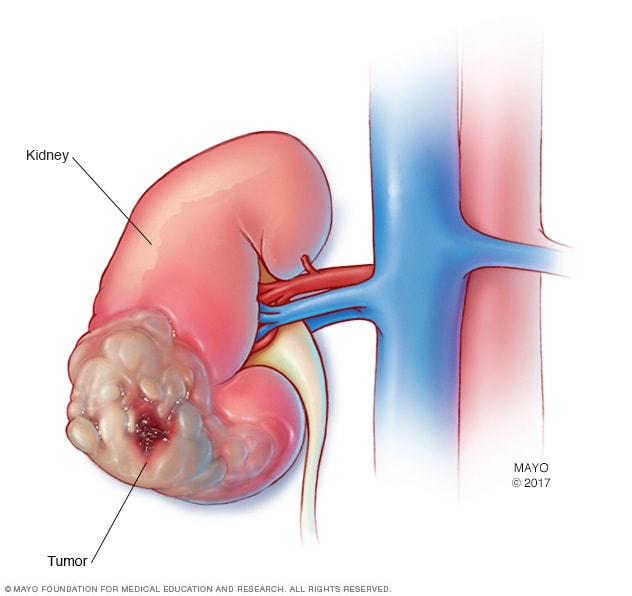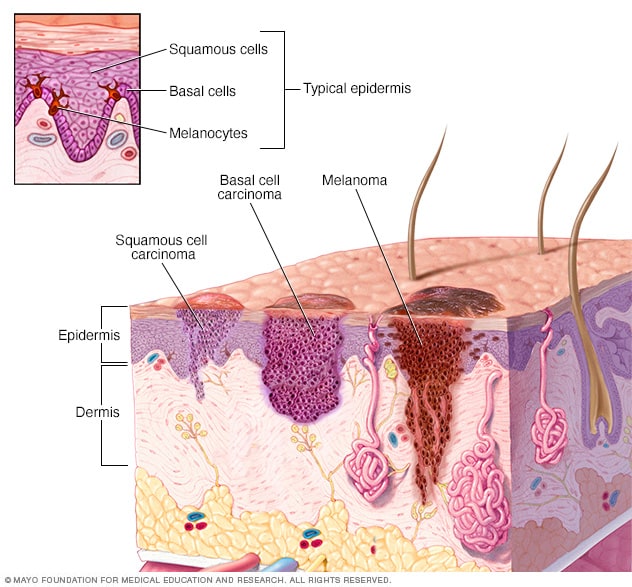Wednesday, February 6, 2019
kidney cancer: Symptoms, Causes, Prevention and Treatment
Kidney cancer also called renal cancer -- is a disease in which kidney cells become malignant (cancerous) and grow out of control, forming a tumor.The kidneys are a pair of bean-shaped organs, each about the size of a fist. They are attached to the upper back wall of the abdomen and protected by the lower rib cage. One kidney is just to the left and the other just to the right of the backbone.
Types of kidney cancer
Renal cell carcinoma
Renal cell carcinoma (RCC), also known as renal cell cancer or renal cell adenocarcinoma, is by far the most common type of kidney cancer. About 9 out of 10 kidney cancers are renal cell carcinomas.
Although RCC usually grows as a single tumor within a kidney, sometimes there are 2 or more tumors in one kidney or even tumors in both kidneys at the same time.
There are several subtypes of RCC, based mainly on how the cancer cells look under a microscope. Knowing the subtype of RCC can be a factor in deciding treatment and can also help your doctor determine if your cancer might be due to an inherited genetic syndrome. See What Are the Risk Factors for Kidney Cancer? for more information about inherited kidney cancer syndromes.
Clear cell renal cell carcinoma: this is the most common form of renal cell carcinoma. About 7 out of 10 people with RCC have this kind of cancer. When seen under a microscope, the cells that make up clear cell RCC look very pale or clear.
- Papillary renal cell carcinoma: this is the second most common subtype – about 1 in 10 RCCs are of this type. These cancers form little finger-like projections (called papillae) in some, if not most, of the tumor. Some doctors call these cancers chromophilic because the cells take in certain dyes and look pink under the microscope.
Leukemia: symptoms Causes Types and Treatment.
Leukemia is a cancer of the blood cells that affects the blood and bone marrow. Leukemia begins in a cell in the bone marrow. The cell undergoes a change and becomes a type of leukemia cell. Once the marrow cell undergoes a leukemic change, the leukemia cells may grow and survive better than normal cells. Over time, the leukemia cells crowd out or suppress the development of normal cells. The rate at which leukemia progresses and how the cells replace the normal blood and marrow cells are different with each type of leukemia.Leukemia usually involves the white blood cells. Your white blood cells are potent infection fighters — they normally grow and divide in an orderly way, as your body needs them. But in people with leukemia, the bone marrow produces abnormal white blood cells, which don't function properly.
Many types of leukemia exist. Some forms of leukemia are more common in children. Other forms of leukemia occur mostly in adults.
Symptoms of Leukemia
Leukemia symptoms vary, depending on the type of leukemia. Common leukemia signs and symptoms include:
- Fever or chills
- Persistent fatigue, weakness
- Frequent or severe infections
- Losing weight without trying
- Swollen lymph nodes, enlarged liver or spleen
- Easy bleeding or bruising
- Recurrent nosebleeds
- Tiny red spots in your skin (petechiae)
- Excessive sweating, especially at night
- Bone pain or tenderness
How leukemia forms
In general, leukemia is thought to occur when some blood cells acquire mutations in their DNA — the instructions inside each cell that guide its action. There may be other changes in the cells that have yet to be fully understood that could contribute to leukemia.
Certain abnormalities cause the cell to grow and divide more rapidly and to continue living when normal cells would die. Over time, these abnormal cells can crowd out healthy blood cells in the bone marrow, leading to fewer healthy white blood cells, red blood cells and platelets, causing the signs and symptoms of leukemia.
Wednesday, January 30, 2019
ALL TO KNOW ABOUT SKIN CANCER
Skin cancer is the abnormal growth of skin cells that is most often develops on skin exposed to the sun. But this common form of cancer can also occur on areas of your skin not ordinarily exposed to sunlight.
You can reduce your risk of skin cancer by limiting or avoiding exposure to ultraviolet (UV) radiation. Checking your skin for suspicious changes can help detect skin cancer at its earliest stages. Early detection of skin cancer gives you the greatest chance for successful skin cancer treatment.
Skin cancer types
Two main types of skin masses exist, keratinocyte carcinoma and melanoma. However, several other skin lesions are considered part of a larger skin cancer umbrella. Not all of these are skin cancer, but they can become cancerous.- Actinic keratosis: These red or pink patches of skin are not cancerous, but they’re considered a form of precancer. If left untreated, these skin masses may develop into squamous cell carcinoma.
- Basal cell carcinoma: The most common form of skin cancer, basal cell carcinomas account for 90 percent of all cases of skin cancer. They’re slow-growing masses that most often show up on the head or neck.
- Squamous cell carcinoma: This type of skin cancer develops in the outer layers of your skin, and it’s typically more aggressive than basal cell carcinoma. It may show up as red, scaly lesions on your skin.
- Melanoma: This type of skin cancer is less common, but it’s the most dangerous type of skin cancer. In fact, melanoma makes up just one percent of skin cancers, but it causes the majority of skin cancer-related deaths each year. Melanoma forms in the melanocytes, the skin cells that create pigment.
What are the risk factors for skin cancer?
PROSTATE CANCER: TREATMENT, CAUSES, STAGES, PREVENTIONS AND DIAGNOSIS.
Prostate cancer is cancer that occurs in the prostate, a small walnut-shaped gland in men that produces the seminal fluid that nourishes and transports sperm.Prostate cancer affects the prostate gland, the gland that produces some of the fluid in semen and plays a role in urine control in men. The prostate gland is located below the bladder and in front of the rectum.
In the United States (U.S.), it is the most common cancer in men, but it is also treatable if found in the early stages.In 2017, the American Cancer Society predicts that there will be around 161,360 new diagnoses of prostate cancer, and that around 26,730 fatalities will occur because of it.
Prostate cancer is the most often diagnosed cancer in Canadian men, aside from skin cancers. It ranks third as a cause of cancer death in Canadian men aged 65 and over.
As an important part of the male reproductive system, the walnut-shaped prostate gland produces liquid that moves sperm. It is located between the rectum and the pubic bone, beneath the bladder.
When the condition is found early, and if it is located only in the prostate gland, treatment of prostate cancer can be more successful. If the cancer spreads to other areas of the body, treatment may become more difficult.
PENCREATIC CANCER : SYMPTOMS, CAUSES, PREVENTION AND TREATMENT
Pancreatic cancer occurs when cells in your pancreas develop mutations in their DNA. These mutations cause cells to grow uncontrollably and to continue living after normal cells would die. These accumulating cells can form a tumor. Untreated pancreatic cancer spreads to nearby organs and blood vessels.Most pancreatic cancer begins in the cells that line the ducts of the pancreas. This type of cancer is called pancreatic adenocarcinoma or pancreatic exocrine cancer. Rarely, cancer can form in the hormone-producing cells or the neuroendocrine cells of the pancreas. These types of cancer are called islet cell tumors, pancreatic endocrine cancer and pancreatic neuroendocrine tumors.
More than 56,000 Americans are expected to be diagnosed with pancreatic cancer in 2019. That is more than 150 people diagnosed every day.
Pancreatic cancer is the ninth most commonly diagnosed cancer in women and the 10th most commonly diagnosed in men in the U.S.
Signs and Symptoms of Pancreatic Cancer
The symptoms of exocrine pancreatic cancers and pancreatic neuroendocrine tumors (NETs) are often different, so they are described separately.
Having one or more of the symptoms below does not mean you have pancreatic cancer. In fact, many of these symptoms are more likely to be caused by other conditions. Still, if you have any of these symptoms, it’s important to have them checked by a doctor so that the cause can be found and treated, if needed.





